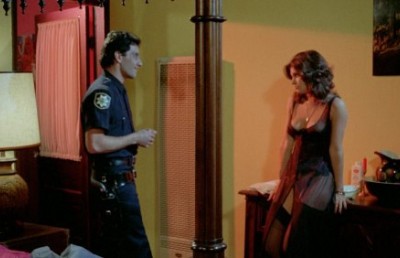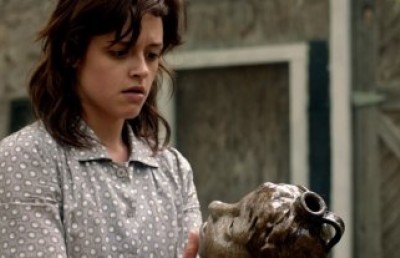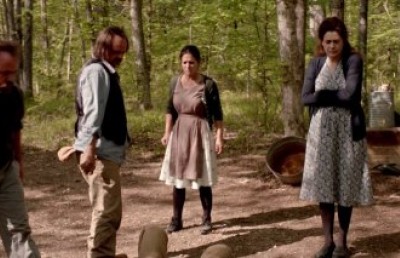An Interview with Scooter McCrae: The Patron “Saint” of Low Budget Horror
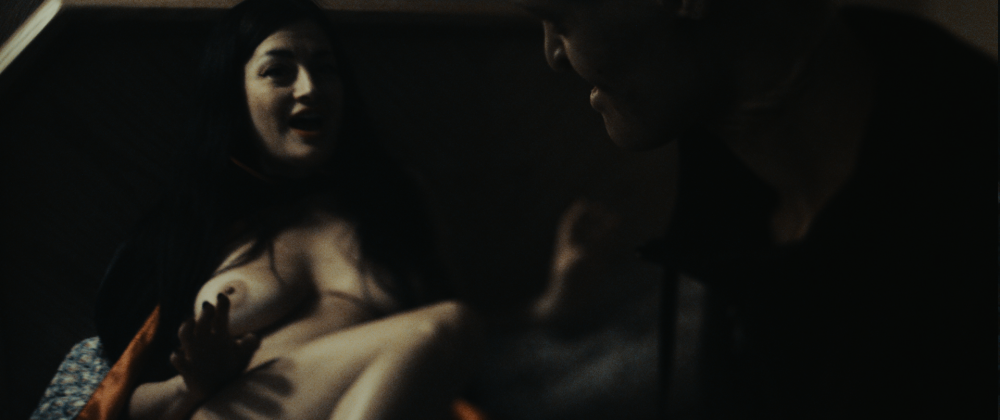
I met Scooter McCrae for the first time when he was in Montreal with his amiable producer Alex Kuciw in 2003 to present the world premiere of his second feature film, the gritty cyperpunk/science-fiction Sixteen Tongues. I wrote the program notes for the film in the 2003 Fantasia catalogue, where I defined the film as one that goes further than most cyperpunk films “in depicting the dark sexual undercurrents of cyperpunk, including brief fusions of science-fiction and hardcore pornography.” His latest short Saint Frankenstein shares this decidedly “non-mainstream” mix of daring sexuality with popular genre (science-fiction, horror). Along with his first feature, Shatter Dead, Sixteen Tongues and Saint Frankenstein are conceptual risk takers, infusing heady ideas about biology, technology, and sexuality into a popular genre mix (horror, science-fiction) that often belie their obvious budgetary limits. McCrae is not afraid to lace his gore with allegory and intellectual speculation. McCrae prefers provocation over easy entertainment. While Shatter Dead reconceptualized the zombie film, long before its recent proliferation, Sixteen Tongues pushed the boundaries of cyperpunk as conceptualized on screen, and Saint Frankenstein reworks the Frankenstein myth with historical reality.
For an engaging look at McCrae’s visit to Montreal in 2003 to present his film, you can watch the three-part video “Fantasia or Bust!”, which is available on youtube. I appear as an interview subject discussing my thoughts immediately after the screening of Sixteen Tongues near the end of Part 2.
This interview was conducted by email.
Offscreen: For those who may not know you, can you give us a brief biography of how you became interested in filmmaking and whether you had any formal training?
Scooter McCrae: Sure thing. The movie that made me want to make movies was STAR WARS, all the way back in 1977. From the first moment I sat there mesmerized by its opening shot, I said to myself THIS IS WHAT I WANT TO DO! So I studied special effects technology and processes, picked up my parents Super-8mm camera and began shooting little puppet movies and eventually, in high school, worked with friends as actors for the first time to create a post holocaust sci-fi movie entitled THE LONER that actually got noticed and screened. Once I realized that I didn’t have the skills to do special make-up effects work, I channeled my energies into writing and wanting to direct, and had the good fortune to make it into the SUNY Purchase film program, which back in the day was considered a conservatory situation as they interviewed about 300 hundred potential students and only chose 20 to participate. By the time I was a Junior, there were only 12 of us left in my class! So it was a trial by fire and one of the most wonderful and educational experience I could have ever hoped for. I’m still in touch with and even work with people whom I first met at SUNY.
Offscreen: I think of you as an archetypical independent filmmaker because you make exactly the kind of film you want to make at that point in your life, with the resources available. And yet you started off with two impressive feature films, in 1994, Shatter Dead and Sixteen Tongues (1999, US release 2005), but have only managed three short films in the next 16 years. Can we read into this that it is harder for the indie filmmaker now than 15 years ago? Which would seem to go against the common notion that the digital revolution has democratized cinema. Or are there other extenuating circumstances?
Scooter McCrae: That’s an interesting question. Let me start by saying that I’ve actually only managed to make one short movie since my two features, so it’s even more dire than your original question implies!
Although the technological tools are more readily available than ever to make independent productions with, and there are more outlets for people to have their work seen via the internet, streaming and cable, I do think the situation is worse for moviemakers with voices that are divergent to what the mainstream outlets are looking to perpetrate on their viewers.
Fifteen or twenty years ago there was a lot more “radical” moviemaking being done than there is now, and I often wonder why that’s the case. The only explanation that makes any sense to me is that the mainstream media has so completely homogenized what kind of imagery modern viewers will accept on their screens. There is very little tolerance for unique or even eccentric storytelling schemes that don’t follow the tease-and-reward patterns of most movies and TV shows these days. Also, there are the established color schemes and “looks” that computer controlled cinematography has bestowed upon the various genres, so you can usually tell within seconds when switching channels whether you have stumbled across a police procedural, a zombie show or a comedy. So where is the surprise there?
The so-called “digital revolution” has simply helped make categorization easier for the producers of content and the viewers who consume the programming. I had an easier time creating bizzaro productions back when it was more expensive to get access to the necessary technology and performers were braver and technicians were more eager to try new things. I think people are now more eager to make sure they don’t jeopardize their next gig than they are uncompromising about making sure their current project is a one-of-a-kind creation that showcases their personal means of expression as opposed to just their technical virtuosity creating commercial product —which the current technology almost guarantees since anything considered aberrant to commercial viability can be digitally corrected into something more normal, even beautiful looking in the most conventional manner.
Offscreen: Your credits include acting, composing, writing, editing, cinematography, and pretty much everything possible. Do you have a preferred technical role? One you like least?
Scooter McCrae: I can’t say that I prefer one technical role over another since, when I’m formulating a project in my mind while sitting down and writing it, oftentimes the cinematography and editing are already happening in my mind as the words spill onto the page (or screen). I’m very aware of budgetary, location and casting restrictions during the creative process and do not see these limitations as being detrimental to the act of creation. In fact, it can be very helpful to set these limits and then explore the options inherent in the resources you know you have available for your project. Working within the realm of the finite is a lot more rewarding than grasping the empty air of infinite possibilities when you are toiling in the world of low-budget moviemaking. It’s one thing to present challenges to yourself, and another thing to bite off more than you can possibly chew —especially if you’re paying for that food whether you can swallow it or not. Moviemaking is still not cheap for us genre folks.
And if you’ve ever seen me acting in a movie, that would be the one area from which I’m better off staying away from.
Offscreen: Saint Frankenstein is obviously an allusion to the classic literary novel, and is a modern (or postmodern?) reworking of the Frankenstein mythology. In a sense, so was Sixteen Tongues. And even Bad Biology [which Scooter McCrae edited] has some Frankensteinian elements. What is it that draws you to that theme?
Scooter McCrae: I’ve often said that Sixteen Tongues was my first attempt to rethink and then reassemble the Frankenstein mythos in an odd way, without dealing with it directly. And although Frank Henenlotter and I are friends who have known each other, I had nothing to do with the writing of either Bad Biology or Frankenhooker (which obviously has its own wild and wooly take on Frankenstein!). We’ve never sat down and talked about it together, but I guess it’s obvious we are both enchanted by particular aspects of this essential mythology.
I’ve always been attracted to detailing the ways in which our bodies are broken down by the universe on a day-to-day basis. Just breathing is an act that wears us out eventually and every day we live is one day closer to our inevitable demise. I have never had any interest in the concept of immortality, but a lot of people do and I think the Frankenstein story is attractive as it taps into that fear of dying and the alternative prospect of being able to live forever instead by replacing the parts of us that fail to function properly anymore with other organs, etc. It sure would be neat if things did work that way, eh?
I really loved the idea of that very basic tenet of organ and limb replacement from dead bodies being only the beginning of the framework for an updated Frankenstein story. I mean, we get it, right? How many times can we retell that same old story over and over again without adding something new and personal to it? Unfortunately, the story appears to have been done to death because so many half-assed moviemakers just do it from rote and offer nothing new, but if you do go to the trouble of personalizing it and taking it to the next level, there is so much amazing material to still be had from that ancient text.
For example, with my version it’s just a given and nothing special that our creature can update body parts as needed, so I was free to move on to the next level from there by suggesting that once you can achieve this, one could be freed from the burden of just trying to follow the established pattern of how body parts are positioned and accounted for. One could have multiples of their favorite parts and then decide where exactly to put them and how to align them with each other. As Shelley says during her monologue: “My father was just a doctor, but I am an artist.” And once you have that established, that our Frankenstein is an artist and a pleasure seeker amongst other things, all sorts of new story ideas develop and the character takes on a whole new life of its own.
Offscreen: Saint Frankenstein taps into a pretty interesting recent trend of adapting the classic monster to an atypical historical or literary tradition. Like Abraham Lincoln Vampire Hunter, Pride and Prejudice and Zombies, Frankenstein’s Army, and a few others. Was this an influence on you in one way or another?
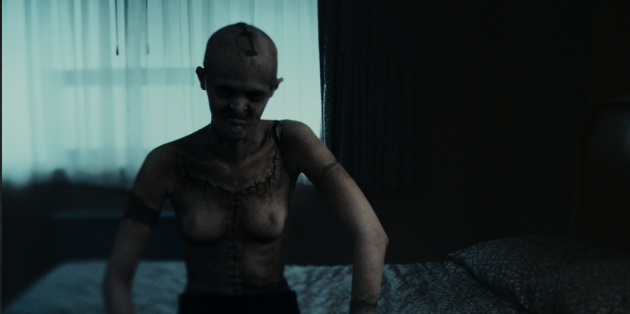
Shelley
Scooter McCrae: Saint Frankenstein is actually a distillation of an idea that I’ve had in the back of my mind for nearly 25 years as it was something I wanted to do right after making Shatter Dead. At the time, it was a radically different project I had entitled “Adolf Hitler’s Frankenstein,” and it was the story of the rival programs Hitler had put into motion in order to create the perfect Aryan Superman —one being headed by Dr. Frankenstein and the other by Dr. Praetorius from The Bride of Frankenstein. I had envisioned doing this in black-and-white utilizing stock footage in addition to newly shot stuff. I wanted it to play like Woody Allen’s Zelig —a fiction created from newsreel footage and other existing historical footage that was bent, repurposed and reconstructed. So I guess even the original thought process of creating this movie was a bit of a Frankensteinian task.
But I couldn’t quite wrap my brain around how to do it in such a way that it could be taken seriously. I simply did not have the resources at my disposal at that time and didn’t want to do a half-assed version. So I just left the idea alone and moved on to other projects, even though it was always sitting there and waiting to be revisited in the back of my mind.
So it’s really just a total coincidence that our Saint Frankenstein happened to finally come to fruition in the midst of this period of historical intertwining of monsters, famous fiction and real life personalities. If anything, it’s nice to see a precedent for this kind of crossover fan fiction (so to speak) spilling into the mainstream. In that sense, I felt no influence whatsoever from any of these much higher-budgeted movies you have listed, although the company is comforting.
Offscreen: Right from your first film Shatter Dead you have always written strong female characters. The assassin Ginny Chin-Chin in Sixteen Tongues (sorry I haven’t seen your contribution to Betamax), to the two (or is it only one?) female leads in Saint Frankenstein. It recalls someone like Romero, who also writes strong female characters (after NOTLD anyway). Strong female leads goes against the perception, or misperception, of horror being full of weak or victimized women. Is this something you consciously set out to do in your writing? Or is it a natural progression of your stories?
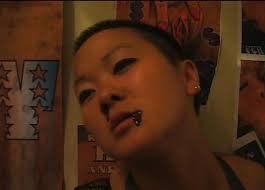
Ginny Chin-Chin from Sixteen Tongues
Scooter McCrae: I’ve never really given the bifurcation between male and female characters —what makes one weak or the other strong — that much thought as I like to think that I’m always writing strong or interesting characters no matter what is going on between their thighs. So it’s definitely not a conscious thing. In Shatter Dead, I knew I had a particular lead actress at my disposal so I wrote the part especially for her. I don’t think anyone wants to watch a movie where your lead character is stupid, so I wrote her as almost smart and resourceful enough to be able to deal with the awful circumstances that surrounded her. In Sixteen Tongues, I had three wonderful lead performers with shifting allegiances in both their characters and their sexualities, so the victimization that happens there bounces around between self-victimization and that which is imposed onto others. That was an interesting situation because in the casting process, one of my male characters morphed into a female character because I ended up seeing two perfect actresses and I wanted to work with both of them, so I just changed the gender and didn’t rewrite any of the dialogue —heck, I didn’t even change their name in the script.
In Saint Frankenstein, the one who appears to be the victim eventually becomes the aggressor and neither of them is what they first appear to be. That’s the kind of writing I’ve been enjoying doing lately. I like hearing monsters talk to each other, especially when they are women, as I have the bad feeling there are a lot of young male horror fans, many of whom make their own movies, who see women as impenetrable monsters. Which is probably why the majority of modern horror movies aren’t terribly interesting.
Offscreen: Shelley’s gender in Saint Frankenstein seems purposefully ambiguous; why did you choose that approach? Is it because gender issues in society are a hot topic at the moment?
Scooter McCrae: I love the Jerry Cornelius character that Michael Moorcock created, and the fluid gender selection and racial orientation he assigned to his creation from one story to the next. In the book version of The Final Programme, Cornelius becomes potentially immortal through the act of self-impregnation from having both sex organs built into his messianic transfiguration by the story’s end. That has always intrigued me and so it became an essential part of my own reconception of the Frankenstein creature. However, instead of this aspect being related to self-replication of our character, I decided to make Shelley an unrepentant hedonist instead because…. why the hell not? Creatures should be able to enjoy sex just as much as we do, and if they have the ability to heighten that pleasure by multiplying the fun stuff on their bodies, than I suppose us mere mortals can do nothing more than look on jealously.
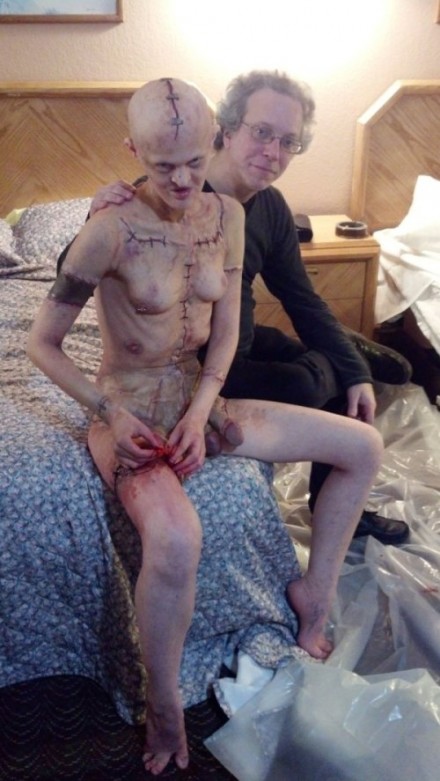
Actress Melanie Gaydos on set with director
I wouldn’t say the decision to do this is because gender issues in society is such a hot and sensitive topic at the moment, but at the same time perhaps subconsciously it is why I found this option so attractive? I always like to think I’m creating with one eye tuned in to what’s happening in the world around me so the projects remain topical and explore issues that are current and sincere. Otherwise, what’s the point of doing all this work? I think more people are frightened of gender fluidity than they are of vampires or similar creatures that are typical to the genre, which is a pretty sad statement of where we’re at right now. But as creators of relevant works of art, we need to address the so-called “horrors” that concern the modern world instead of constantly looking back at the old models for inspiration —unless, of course, we are redesigning those old models for modern consumption in a personally meaningful way. George Romero has always been especially good at doing this when it comes to his zombie movies, whereas few others seem to know what the fuck to do with the living dead to make them socially relevant beyond being eating machines.
Offscreen: I know you’ve worked with Tina Krause before. Can you talk a little about the casting of Krause and Melanie Gaydos? I’ve researched Gaydos a little and know about her physical condition (partially blind, ectodermal dysplasia) and the way she has made surprising inroads in modeling. She seems like an amazing person. As does Krause. Can you talk about what it was like working with them?
Scooter McCrae: Casting Tina was easy as I wrote the part with her in mind. I love the fact that she is traditionally beautiful and at an age where you really cannot tell how old she really is. You get the feeling she is older than she appears, and not in a negative way. I wrote something that I thought played to her strengths as she is pretty damn funny and such a blast to work with. She is completely unselfconscious and has no qualms about rolling around naked for nearly two days on-set and she has the ability to deliver a compelling performance while in that state. She is one of the last secret weapons that moviemakers like myself have left in our arsenal these days. Good luck trying to find that combination of beauty, talent and a joy for risk-taking in most performers. It’s just not there as much anymore.
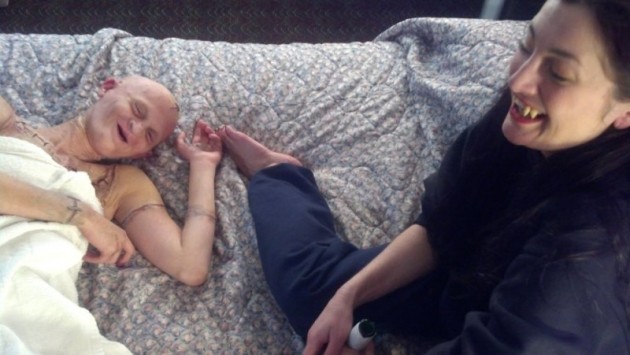
Gaydos and Krause share a laugh in-between camera setups
Melanie is an unbelievable force of nature that we were so lucky to connect with on this project. I wrote the script before I envisioned her in the role of Shelley. In fact, in my mind’s eye, I had a much more traditionally beautiful looking woman in mind, but I’m glad that idea went away quickly! My dear friend and co-collaborator since college Dan Ouellette —who is also a filmmaker and fine artist in his own stratosphere— made me aware of Gaydos when he one day sent me a link to online images of her he thought I would find intriguing, He sent me that not even specifically for this movie, but just in general as we’re always making each other aware of interesting stuff. So at some point Melanie just clicked into my brain and I realized that nobody else could play this part the way she could.
As you pointed out, she has ectodermal dysplasia —which is the same series of genetic disorders that Michael Berryman has. It makes her physically delicate, which means we had to be careful when applying sfx make-up and during the fight scene at the end. We had a stunt person around to watch out for the safety of both of her and Tina during their brief battle.
Producer Alex Kuciw and I also realized the first time we met Melanie that, although she was visually perfect for the part and she gave a great read from the script, there was a very good chance that we would have to post dub her dialogue as she has a very high-pitched voice which would immediately solidify the gender of Shelley’s character to audiences. As we didn’t want to surprise her or make her think that we weren’t being entirely honest with her, we let Melanie know right upfront that this would probably be the case, as we wanted a more gender-neutral voice. She wasn’t terribly happy about that —who would be? But at the same time, she loved the script and also loved being given the opportunity to play a character and not just a face, which had mostly been the case for her up until this point.
Melanie was exquisite on-set and created a performance and character beyond anything we could have hoped for. With Tina, we knew the quality of what would she could deliver, but Melanie was an unknown quantity, so we were ready for anything there. Happy surprises are always the best ones on a project like this! To watch the two of them playing off of each other —each one a unique beauty yielding quality performances— was a director’s dream come true. I hope I get the opportunity to work with both of them again someday.
Offscreen: Even considering Gaydos’ condition, the make-up on the Shelley character is great. Who did it? And what was the conceptual origin of it. It is very creepy.
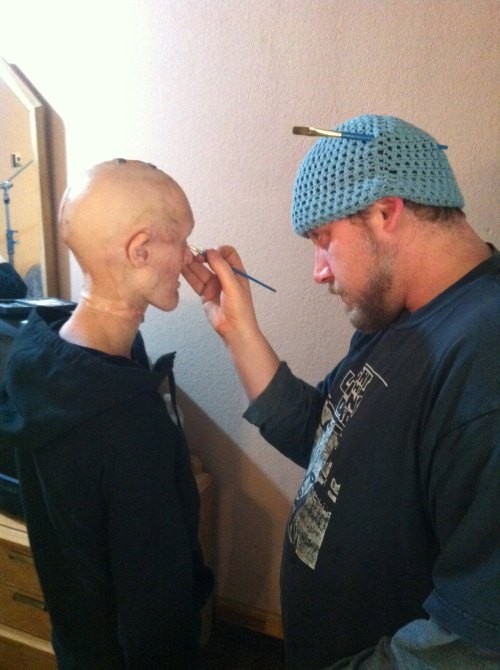
Gaydos with sfx make-up artist Brian Spears
Scooter McCrae: What is beautiful can also appear to be quite creepy, which is a very difficult balance to maintain. Brian Spears and Pete Gerner were the guys who designed and applied the make-up on Melanie and they did a great job working with and building upon what was already there with her. They worked fast and got the job done with a quality look that belies the low-budget they had to work with. Also, they did a great job being on call all day during shooting to do touch-ups and little fixes that happen to an sfx make-up when you’re shooting over the course of a long and physically demanding day on location.
One thing I’d like to mention here that concerned Alex and I from day one of hiring Melanie for this role that I want to be clear about, is that she was not hired simply because we were trying to exploit the dysplasia she was born with. Just because we are making an “exploitation” movie does not mean that we are actively seeking to exploit someone because of a physical condition that makes them special. Yes, Melanie has a very unusual look, but as you pointed out she has been able to channel that into a successful modeling career. She’s whip-smart and read the script and from the title page she knew that we were interested in her because of the production value her appearance created, but also she gave a great read and we could tell immediately that she’d be a charm to work with. I think it’s a fine line between offering someone with such a unique look a legitimate part or hiring them as a piece of stunt casting, but we definitely respected and appreciated the fact that she understood where we were coming from (which was NOT exploiting her) and she also loved that we had given her a screen role that really helped her display her exceptional acting talents. I remain hopeful that her performance in Saint Frankenstein helps her to secure many more roles that might be considered unconventional for such a special beauty and talent. She’s earned that opportunity.
Offscreen: Was the idea of referencing the Holocaust a way to show these character’s immortality while raising awareness of the horrors of the war?
Scooter McCrae: More than anything else, I liked the idea of our Frankenstein creature being entwined in real human history. The more I’ve been working on the novel with this character, the more events of the last 200 years or so I’ve found benefit from having Shelley involved in them in one way or another. It carries on the tradition from the original novel of the creature being intelligent and poetic, which is so much more intriguing than a mindless mass of angry muscle tearing up the lab and the countryside. I am still amazed at how lazy filmmakers get with this wonderful creature, diminishing it from the lofty heights from which it was originally envisioned into nothing more than a marauding undead hulk. In the original novel, it is Frankenstein himself, and not the creature he creates, who is more of a monster (at least for awhile).
Also, I’ve also thought there was something very Frankenstein-like about the Nazi’s tattooing numbers onto their victims, collecting teeth with gold fillings and metal glasses frames and everything else they were cataloging that is absolutely ghoulish and not so different in my mind than hunting down perfect body parts to create the perfect specimen from them.
In my original conception of “Adolf Hitler’s Frankenstein,” I had a scene where Frankenstein’s creation is presented to Hitler for the very first time for inspection. Hitler circles the creature, looking it up and down while admiring the handiwork, until he notices a tattooed number on one of the arms and realizes that what he is looking at has been manufactured from the bodies of the dead Jews that have been piling up at the death camps. Incensed, he turns to Frankenstein and screams, “You idiot —you cannot create perfection from garbage!” That should give you some idea of why I’ve chosen to tone down and soften that original conception into the much more family-friendly movie that Saint Frankenstein has become…!
Offscreen: Are we supposed to think that the Shelley creature is made up only of Holocaust victims?
Scooter McCrae: I hope not! We only show the number tattoo on one section of the arm to indicate that this more aged-looking body section was from a death camp victim, but I never wanted to imply that the whole body had been stolen wholesale from the Holocaust era. Some sections are more damaged than others of Shelley’s body —a few slices from various ethnicities as well are mixed into the final amalgamation.
Carla’s leg at the end being the most recent addition, I’m hopeful viewers will get the idea that the continuation of Shelley is an ongoing project that is in a state of constant refurbishment when necessary. Like all great works of art, Shelley is never really finished, just eventually abandoned.
Offscreen: The implication would be that Frankenstein was performing his experiments in concentration camps, would that be accurate?
Scooter McCrae: Actually, unlike my description of the original idea that eventually morphed into this project, it would be Shelley who, moving forward with all the knowledge she accumulated and has since brought to the next level, is the one continuing the Frankenstein tradition while working for Hitler’s regime. To Shelley’s credit, it was under duress and coercion, although that is informed by the Saint Frankenstein novel I have started working on since finishing this project. The character is just too rich for me to leave alone after creating this first slice of a much larger narrative pie.
Given a choice, Shelley would not be stealing body parts from suffering innocents and would much prefer to be rebuilding herself from limbs obtained from deactivated vampires —a source of some rich folklore in the novel.
Offscreen: Are you a fan of any other Holocaust or Nazi themed horror?
Scooter McCrae: I can’t say I’m particularly a fan, but I find the sub-genre fascinating because it is just so recklessly distasteful in its aspirations and execution that there are no other movies like it in the entire diseased pantheon of bad taste cinema. I watched a lot of them many years back and I think they helped inform how I approached the subject matter myself on this project —which is to say, I tried to apply some discretion and something resembling restraint concerning the most exploitative aspects. For a quasi-naziploitation movie, I think I did okay. Being Jewish myself, I certainly come to the more unsavory material with some queasy worries, but also a bit of a “Hey, fuck you, Hitler —my people made it!” attitude. I think if anyone can write this kind of material and get away with it, it’s Jews. We’re always organizing meals to celebrate the occasions where someone tried to kill all of us but failed, so why not movies too?
Offscreen: The vampire Carla mentions that her feet are her wings (in reference to her tattooed leg); the creature attaches that leg (after killing the vampire with a traditional stake in the heart) to itself and leaves the hotel room. Then over the door you show the leg in a transparent image moving up and down as if the tattooed bird is flying away to freedom, and then the credits begin and at the end the dedication to Walerian Borowczyk, Jean Rollin, Jesus Franco and Linay Romay; I’m probably stretching here, but was the floating leg supposed to show the free souls of these artists? A kind of farewell to all of them?
Scooter McCrae: You’re not stretching as much as poor Tina did in order to achieve that shot! It was not in the script and during the shoot, I was compelled to acquire this slow motion footage of Tina’s winged foot in between set-ups because it suddenly burned itself into my mind while we were working. The crew was concerned about what I was trying to get with this shot as we were on a very tight schedule and it took some time to get the correct framing and the exact trajectory that I wanted Tina to swing her leg and foot in. When I got asked what scene we were shooting this for, I invoked what I’ll call “Director’s Privilege” and said I wasn’t quite sure myself (which was true), but that I would definitely need it in the edit.
Your interpretation of this final moment is interesting and I have no argument with it as it may very well have been on my mind while we were shooting it as well, since from the first moment we decided to go ahead with this script Alex and I were aware of the presence of that list of cinema heroes hovering over us while we were making this project. I love all of them for different reasons, but the one thing they all had in common is they had unique cinematic languages and forms of expression that were specifically their own. I think these artists all had free and fully expressed souls before I came along to dedicate my little movie to them and their works. The movies all of them made continue to inspire me and always will. As the world gets more conservative with each passing year, their gleefully anarchic and sexually liberated works seem like more of an anomaly that we’ll never see the likes of again in cinemas. I think we miss them a lot more than they miss this crazy, mixed-up world.
Offscreen: Another question on the dedication. The dedication made me think specifically about Franco’s Dracula Contra Frankenstein. Does this also play a part in having these two characters dueling together?
Scooter McCrae: I can’t say that was a direct inspiration, but I do love those Franco Monster-thon movies, especially The Erotic Rites of Frankenstein, so there is definitely something to that idea as I wrote a movie where epic creatures derived from the Frankenstein and Dracula mythologies have an adventure together in a hotel room. The smallness of the production overall, the spareness of resources during production, was in my mind a callback to what directors like Franco and Rollin were doing back in the day when making their own handmade films. And while I can hardly compare what I’ve done to the timelessly inventive movies they made on 35mm film, that they still give me something to aspire to brings me a lot of comfort. I don’t see many contemporary movies that actually inspire me to want to make movies.
Offscreen: And speaking of homages, I love the 1970s font style you use for the film’s title. It is so 1970s, especially Franco.
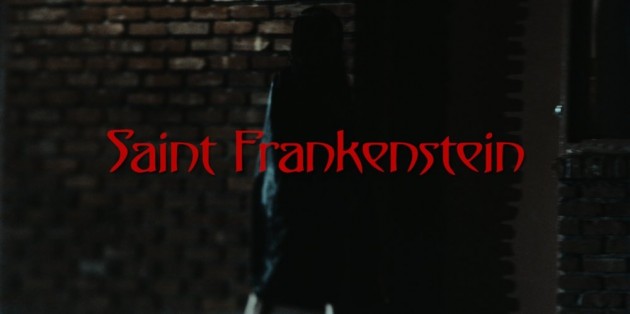
Scooter McCrae: It’s hilarious that you should say that, because when we screened the movie at TIFF (Transylvania International Film Festival) this past summer, we won the award for best genre short movie —which was a great honor, especially as were up against some excellent competitors. But what was funny is that the judges confronted me after the win to let me know how much they HATED that font despite the fact that they otherwise liked the movie a lot! In fact, one of the judges said they almost stopped watching the screener immediately because the font was so “old fashioned” and annoying in its attempt to appropriate an era that it completely put him off. I’m glad he continued to watch it, of course! It amazes me how polarizing a detail like this can be to more informed viewers; I guess it can really make or break their reaction to a project depending on how they feel about this kind of cultural thievery. Needless to say, I’m glad you like the font as much as I do and for the same reasons.
Offscreen: Thematically Shelley’s multiple erogenous zones recalls Sixteen Tongues and Bad Biology. What is it with multiple erogenous zones?
Scooter McCrae: I personally have erogenous zones that are in a constant state of flux, moving from one part of my body to the other over the course of time, so I guess it’s something that I have a natural attraction to writing about. As monsters in our modern world are akin to the gods of ancient mythologies in some ways, one of the things that separated us from those gods is their irresponsible hedonism; always raping and drinking and otherwise making merry at our expense. I see no reason why the beautiful monsters of everything I’ve created so far would not want to live in a constant state of pleasure if such a thing were achievable. That’s the modern definition of Heaven, I think? A never ending state of bliss.
Also, people tend to focus on the most obvious dispensers of joy our bodies offer, a great many of which are sexual in nature and focused specifically on our genitalia. Implying that sexual pleasure can be obtained by figuratively shifting everything over to the left a little bit helps defamiliarize these most obvious choices and, I hope, helps to create questions and even confusion as to what gives and what provides pleasure. Once you cross that line, you start getting into fetishes, and once you start questioning the nature of what a fetish is and how it displaces or replaces “normal” or “vanilla” sexual desire, you start getting into the more interesting ways in which our brains function.
Offscreen: The look of the film, with the soft focus, the soft music, makes the film feel like a porn film at times. But then of course there is the gory pay-off that reels it back to horror. Horror and porn are often linked. Linda Williams links them in her essay “Body Genres” (horror, melodrama, porn) and then there is the more recent assignation, torture porn. What is your interest in fusing elements of porn and horror?
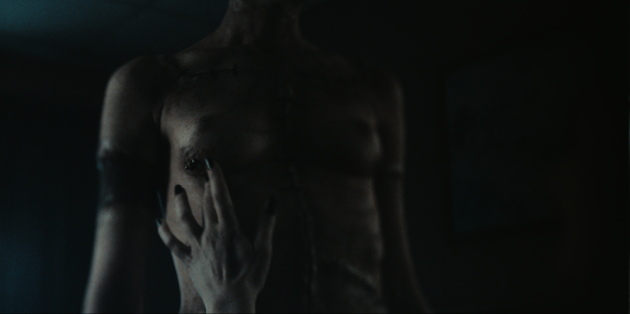
Scooter McCrae: I guess the most horrifying thing that can happen in a horror film is that a character dies, whereas in a porno movie the worst thing that can happen is the lack of an orgasm (or, to follow the metaphor, “the little death”). It’s unfortunate that porn has such a bad rap as there are so many wonderful possibilities for expanding a viewers mind in a sex film than there is in most horror movies —part of the reason being that the horror genre is so reductive and conservative about female sexual activities and the consequences they lead to (i.e.: nothing good and usually death). Porno films are equally reductive, but at least the good ones celebrate a woman’s healthy sexual libido and curiosity is often rewarded as opposed to punished. Please note that I said “the good ones”, as there are an awful lot of bad ones out there since there are so damn many of them.
I don’t think my work is fusing porn and horror so much as it is unleashing the sexual potential that is so often lurking in the subtext of the horror genre and making it part of the text. The puritanical nature of horror needs to be addressed and then assaulted from within, so no need to splice anything like porn into the mix —all the elements are already there and waiting to be explored by the adventurous. It’s a pity that David Cronenberg has abandoned the genre; we need more exploratory works like his old stuff than reactionary bullshit like IT FOLLOWS that seems to think it’s subversive in some way. It’s not.
That music you refer to, by the way, is the work of fantastic composer Fabio Frizzi, who scored all of my favorite Lucio Fulci films (The Beyond, The Gates of Hell, etc.). I still cannot believe how lucky we were to work with him, which is a long story unto itself. I do believe that he wrote for us one of the most beautiful themes I have ever heard him compose, which is really saying something! As I’ve said to Alex numerous times, if I ever make another movie again, it will be mostly because I want to hear whatever it is The Maestro can conjure up for our humble little movie. To be given such music on a small project like this is truly a gift bestowed by a great artist.
Fabio Frizzi playing the Saint Frankenstein theme live
Offscreen: A general final question. Since your film work is (unfortunately) sporadic what do you to do keep busy in between making film?
Scooter McCrae: I’m constantly shooting and editing video material for a book publisher, so my day job is putting together mini-documentaries about writers and their upcoming books. It’s a dream job in some ways and keeps me busy in-between my own little movies, which can sometimes take many years to finally come together, but I’d rather it be this way than me trying to support myself by writing or directing projects I don’t fully believe in 100%. I consider myself very lucky to be proud of every project I’ve written and directed so far, even when I’m aware of their failings. I’ll die a happy person knowing I didn’t have to compromise my self-expression on my personal projects. Nobody should have to sell their soul when making home movies!
To purchase or stream a digital copy of Saint Frankenstein please head over to this Vimeo page.
https://vimeo.com/ondemand/saintfrankenstein
(It’s very cheap, so what are you waiting for?)
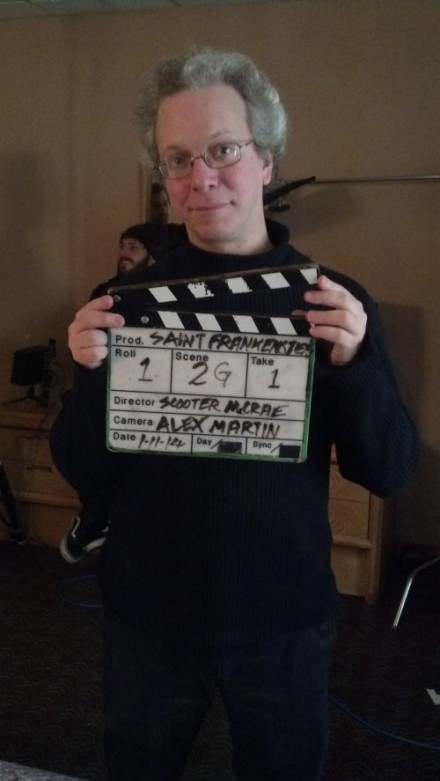
Director Scooter McCrae: “action”
Trailers:




